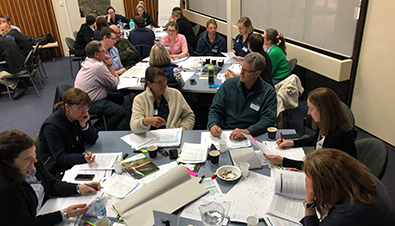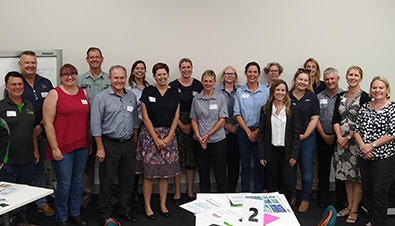Read the latest information on
Foot-and-mouth disease

Industry contacts worked through an incursion scenario at Exercise Blueprint in August 2019
The leaders in your peak industry body are your main contact and source of information during biosecurity incidents, but do you know who they are?
Rod Turner, General Manager for Partnerships and Plant Health Australia, said the peak industry body that represents your biosecurity interests may not be who you think it is.
“For example, the grains industry biosecurity representative is Grain Producers Australia. For grazing cattle, it is the Cattle Council of Australia,” said Rod.
“If they are members of Plant Health Australia or Animal Health Australia and have signed either the animal or plant emergency response agreement – sometimes referred to as the EADRA or EPPRD – they will have a seat at the table when decisions are being made about what will happen – if anything – in response to an new pest or disease being found in Australia,” explained Rod.
For some incursions by pests that affect multiple crops or types of livestock, multiple industry organisations may be involved in decision making, alongside representatives from the state, territory and Australian Governments.
“They will attend meetings to discuss the latest updates on where the pest or disease has been found, diagnostic information about the pest or disease, who’s doing what, the actions that should be taken to eradicate or contain the pest, and who will be paying for it.”
“In an emergency response, industry leaders are the best source of information when decisions are being made because they know the industry and how it works, its concerns, the supply chain and logistics, where people are, who’s who in the industry and how to contact them.”
Rod said that it’s a demanding role because representatives from peak industry bodies relay information between the producers in the industry and the governments, and back again.

Industry liaison training session in March 2020. These people are from Australian Banana Growers’ Council, Bundaberg Fruit and Vegetable Growers, Australian Mango Industry Association, Avocados Australia, Herbert Cane Productivity Services, Sugar Research Australia, Mackay Area Productivity Services, Queensland Berry Industry , Australian Ginger Industry Association, Australian Lychee Growers Association, Growcom, Agri Supply Global, CottonInfo, Cotton Australia and Biosecurity Queensland
Industry leaders may have liaison experience from actual incursions, done training or attended simulation exercises, so they know what to expect and the processes.
Not only will industry leaders be an important source of local information and making decisions, but they will also be the best source of news and information for you, the producers who may be affected.
“While state or territory department of primary industries will release information during a response, industry leaders will also be responsible for sending out information and situation updates to growers.”
Many will have collated information in fact sheets or on websites about what the pest or disease looks like, what to look for on your crops or livestock and when, and on-farm biosecurity measures that should be ramped-up in response to the threat.”
“Whether you are a card-carrying member of the peak industry body or not, they will be representing your interests during a biosecurity emergency.”
There are things you can do to prepare, so you don’t get caught without the information you need or know what’s happening and how it may impact you, your family or employees.
“The first thing is to know who your peak industry body is. They are listed on the Plant Health Australia and Animal Health Australia websites.”
You can sign up to become a member or receive newsletters and notifications. You could also follow the peak body on Twitter or Facebook.
On a final note, Rod said that you don’t need to be a member of the peak industry body to benefit during an emergency response.
“All levy paying producers whose industry has signed the emergency response agreement will be treated the same.”